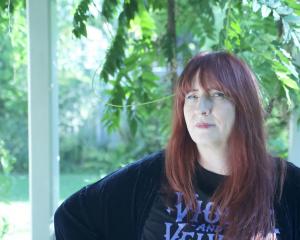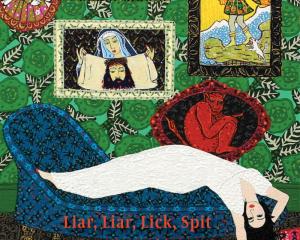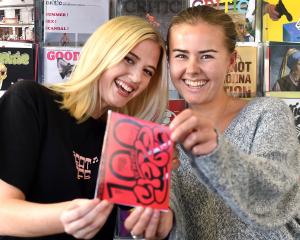
Cinderella and Sleeping Beauty relied on princes to rescue them but in a new book for children, the women are the heroes.
Go Girl: a storybook of epic NZ women features 48 real-life go-getters, from astronomer Beatrice Tinsley and activist Whina Cooper to spy Nancy Wake and golfer Lydia Ko. Each short story is accompanied by a full-page portrait drawn by a female illustrator.
The Dunedin-based author, Barbara Else, says it is designed to inspire girls and give them the confidence to follow their own paths.
Published amid growing calls for action against sexual harassment and gender stereotyping, Go Girl could be seen as New Zealand's answer to an international bestseller that told the stories of women as diverse as Cleopatra, Amelia Earhart and Hillary Clinton. Good Night Stories for Rebel Girls, published in 2016, was praised as being an alternative to the stereotypical portrayal of girls in fiction, such as the Disney princesses.
Else says when she was at school, there simply weren't stories about successful women unless it was Marie Curie and Florence Nightingale.
"History books focused on male achievement; warriors, kings and that sort of figure.
"So all of a sudden, when Goodnight Stories for Rebel Girls was published, it was as if it opened the floodgates. But I suspect it was just part of the zeitgeist ... A lot of people were thinking it was time to bring women out of the shadows where they had been put."
"We have to be heard now. It's high time. Stories about women are centuries overdue."
Research shows that up to the age of about 7, girls believe they can be anything at all when they grow up, she adds. However, after 7, social conditioning kicks in and they narrow their choices much more.

One thing that struck her as she worked on the book was the "generosity" of New Zealand women "working for fairness and struggling with social issues that sadly are still with us today", she says.
These included the country's first female GP, Margaret Cruickshank, who gave her life for her community by over-working during the 1918 influenza epidemic (a statue of her in Waimate is one of very few statues of women in New Zealand that are not Queen Victoria); Lisa King, whose business, Eat My Lunch, has given thousands of free lunches to school pupils; and the country's first woman MP, Elizabeth McCombs, who campaigned for the rights of women and the unemployed. Her story on McCombs reveals that even her own sisters did not expect much of her.
Publisher Penguin Random House wanted the facts "of course" but asked Else to use techniques of fiction in order to engage younger readers.
"So it is more stories rather than biographies. I did think it should come with a little flashing neon warning sign saying, `Do not rely on this book and this book alone for your school projects'," she says, laughing.
The first task was to choose who to include from an initial list of 200 women. There had to be a range of cultures and achievements and a mix of historical and contemporary figures. The earliest story is that of Ahumai Te Paerata, a warrior during the New Zealand Wars; recent achievers include Sophie Pascoe, Parris Goebel and Lorde.
Else's only regret is the absence of some professions, such as engineers and architects, something she hopes will be addressed if a second volume is published.
Other women who had achieved "fantastic things" were ruled out because the book was aimed at children aged from 7 up and the areas they worked in were "best left for an older age group".
"Two that would spring to mind for anyone would be Ettie Rout and Louise Nicholas."
The aim was to find interesting stories about how the women became successful so readers could see what they needed to do to achieve their goals. In many cases, the story was in the struggle, not necessarily the final outcome.
One example: Dame Suzie Moncrieff who failed to get into art school but went on to become a sculptor and to found the World of WearableArt (WOW) competition that attracts entries from more than 40 countries.
"It's figuring out how you can achieve your dream and working at it: find you own way. Keep going. Don't be told you can't and don't tell yourself that you can't. I think just seeing the examples in the book will give girls confidence."
With only four months to complete the text, Else had to research and write at least three stories a day to allow time for editing. Writing to a deadline for the first time was "abominable" but the hard work paid off: Go Girl topped the New Zealand children's and teens' best-sellers list for the first two weeks of this month.
While most who buy the book will be female, Else says it is important for boys to read it, too. Like girls, they have been deprived of stories about strong women and have been the victims of stereotyping.
Recently, she was delighted to come across Stories for Boys Who Dare to Be Different, which presents a wider range of role models than the usual warriors and sportsmen.
"Most boys would admire that sort of thing but would prefer to be something different themselves. So it's time everyone was encouraged to find their own ambition, without feeling that they're lesser than other areas of achievement."
Above all, she wants every child to identify with someone within the pages of Go Girl.
"Whether it's because of their [race] or what they're interested in or their family background, whether it's a girl with a lot of siblings or a girl with older sisters who didn't think much of her, I want everyone to feel, `Ahh, that one's like me'."
About the author
Fiction writer and playwright Barbara Else was born in Invercargill and educated at the University of Otago.
The Warrior Queen, which was shortlisted for the 1996 Montana New Zealand Book Awards, is one of six novels she has written for adults. She has also written six novels, and edited eight collections of stories, for children.
Else has been awarded the New Zealand Order of Merit and the Margaret Mahy Medal for services to literature.
She moved to Dunedin in 2016 and has just completed a children’s novel that she started during her tenure as University of Otago College of Education Creative New Zealand children’s writer in residence that year.
Her husband, Chris Else, and one of her daughters, Emma Neale, are also authors.
Writers and readers
The Dunedin Writers and Readers Festival is gathering several well- known women together to celebrate the release of Go Girl.
"Every Girl can be a Go Girl" will feature Kanoa Lloyd (ex-Queens High School pupil, now co-host of TV3’s The Project) talking with Go Girl author Barbara Else, marine biologist Ingrid Visser and illustrator Phoebe Morris, about girls, goals and grit on Sunday, May 13 at 1pm in Otago Museum’s Hutton Theatre.
Tickets ($10), are available at the University Book Shop or online at www.unibooks.co.nz.
The Weekend Mix has a double pass to give away to a reader. To go in the draw, email playtime@odt.co.nz with Go Girl in the subject line, by noon on Wednesday. Please include a daytime phone number.













